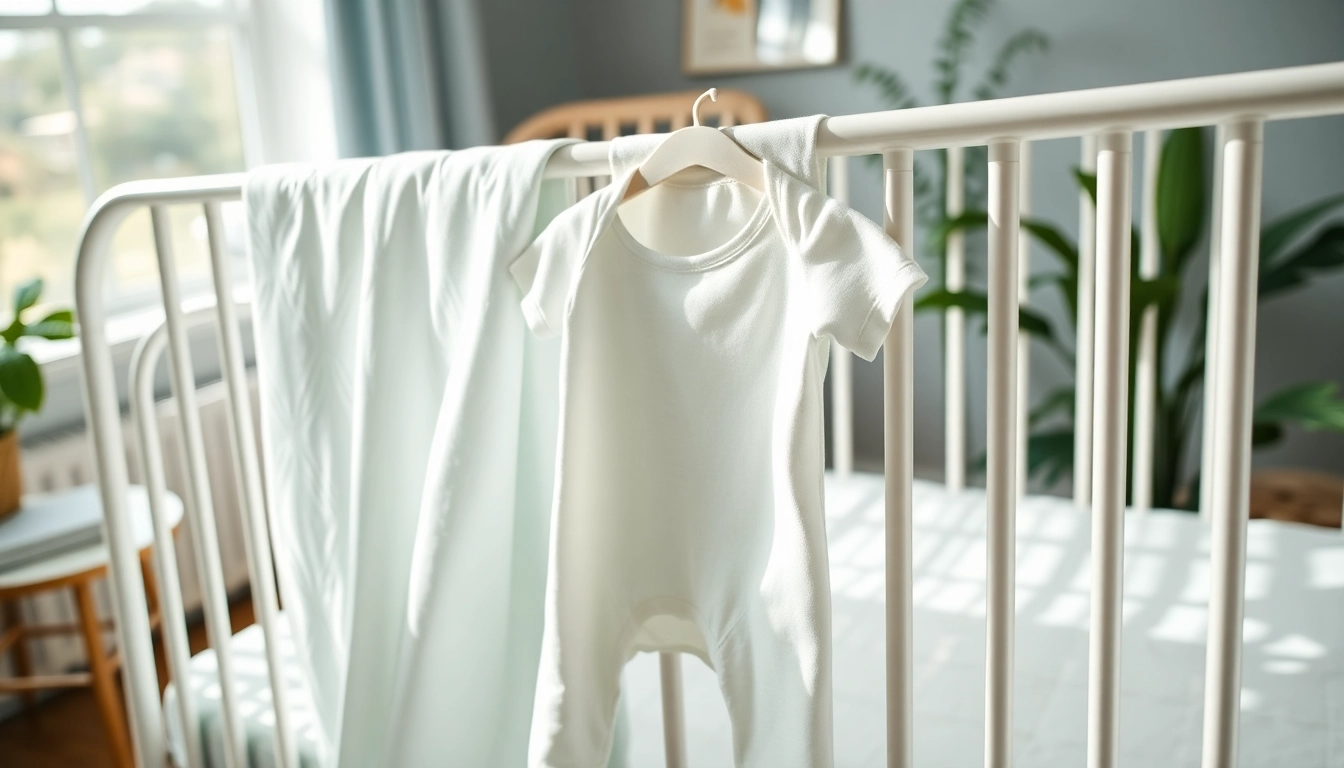
Understanding Bamboo Baby Clothes
What Are Bamboo Baby Clothes?
Bamboo baby clothes are clothing items designed for infants and toddlers that are made from bamboo fibers. These fabrics are derived from the pulp of bamboo plants, which undergo a process to create viscose, a soft and versatile material. Parents are increasingly turning to bamboo baby clothes due to their environmentally friendly production methods and the unique properties of the fabric itself. Bamboo baby clothes offer a blend of comfort and sustainability, making them a popular choice for conscientious consumers.
Benefits of Bamboo Fabric
Bamboo fabric offers a plethora of benefits that make it particularly suitable for baby clothes. Firstly, it is incredibly soft, often softer than cotton, providing a gentle touch against sensitive skin. Secondly, bamboo fibers have natural moisture-wicking properties, meaning they can effectively absorb sweat and keep your baby dry and comfortable. Additionally, bamboo fabric is highly breathable, which helps regulate temperatures and reduce overheating. Lastly, because bamboo grows quickly and requires less water compared to traditional crops, it is considered a more sustainable option for clothing manufacturing.
Sustainable Production Practices
The production of bamboo baby clothes is generally less harmful to the environment than that of other fabrics, primarily due to the rapid growth cycle of bamboo and its minimal need for pesticides. Bamboo is harvested without the use of harmful chemicals and can be processed into fabric using less water than cotton. Moreover, several manufacturers utilize eco-friendly practices when turning bamboo into fabric, such as closed-loop processes that recycle water and chemicals. By choosing bamboo baby clothes, consumers can support sustainable practices and promote environmental health.
Key Features of Bamboo Baby Clothes
Softness and Comfort for Babies
Softness is one of the defining characteristics of bamboo baby clothes. The natural fibers produced from bamboo plants create a velvety texture that is especially comfortable against a baby’s delicate skin. This softness can help to minimize irritation, reducing the chances of rashes and discomfort. Many parents have noted how their little ones feel more relaxed and sleep better in bamboo garments due to this remarkable softness.
Hypoallergenic Properties
Many infants have sensitive skin, making it essential to select clothing that doesn’t irritate. Bamboo baby clothes possess hypoallergenic properties, which means they are less likely to cause allergic reactions compared to synthetic fabrics. The fibers are naturally resistant to mold and mildew, providing added protection for babies who may be prone to skin reactions. This makes bamboo clothing an excellent choice for babies at any age or skin type.
Breathability and Temperature Regulation
Bamboo fabric excels at breathability, helping to keep the body cool in hot conditions and warm when temperatures drop. This thermoregulating ability ensures that your baby stays comfortable throughout the day, regardless of the weather. The structure of the bamboo fibers allows for excellent airflow, significantly reducing the chances of overheating, which is particularly critical for babies who may struggle to regulate their own body temperature.
Comparing Bamboo Baby Clothes to Other Fabrics
Bamboo vs. Cotton: A Detailed Comparison
When comparing bamboo to cotton, bamboo often comes out ahead in several categories. Bamboo fibers are not only softer than cotton fibers, but they also provide superior moisture-wicking and temperature-regulating properties. While cotton absorbs moisture, it can retain it, potentially leading to discomfort. Additionally, bamboo requires less water and fewer chemicals in its cultivation, making it a more environmentally friendly choice. Furthermore, many bamboo fabrics are produced through eco-conscious processes that reduce waste compared to traditional cotton manufacturing methods.
Durability and Longevity of Bamboo Baby Clothes
Bamboo baby clothes are known for their durability. The fibers are resilient and hold up well in both washing and everyday wear. With proper care, bamboo clothing can maintain its shape, size, and softness over time. This longevity not only makes bamboo baby attire a cost-effective choice for families, but it also promotes sustainability by encouraging fewer clothing replacements and reducing waste.
Environmental Impact Assessment
The environmental impact of bamboo baby clothes is notably lower than that of conventional fabrics. Bamboo can grow up to 3 feet in a single day, making it a rapidly renewable resource. It also requires minimal water, does not rely heavily on fertilizers or pesticides, and contributes to soil health. Additionally, the carbon footprint associated with bamboo textile production is significantly smaller due to fewer harmful emissions generated in the manufacturing process. By opting for bamboo baby clothes, consumers make a conscious choice that supports ecological sustainability.
How to Care for Bamboo Baby Clothes
Washing and Drying Tips
To maintain the quality and longevity of bamboo baby clothes, proper washing and drying techniques are essential. It is generally recommended to wash these clothes in cold or lukewarm water to minimize fabric shrinkage. Utilizing a gentle cycle will help preserve the softness and strength of the fibers. When it comes to drying, it’s best to avoid high heat; air drying or tumble drying on low can significantly extend the life of bamboo garments.
Avoiding Common Mistakes
One common mistake parents make when caring for bamboo baby clothes is using harsh detergents that contain bleaching agents or fabric softeners. Such products can break down the fibers and strip away the natural properties of bamboo. Instead, opt for mild, eco-friendly detergents specifically designed for sensitive skin. Another mistake is mistakenly washing with heavy fabrics, which can create friction and lead to pilling; washing bamboo items alone or with similarly lightweight garments can prevent this.
Tips for Preserving Fabric Quality
To preserve the quality of bamboo baby clothes, it’s advisable to avoid prolonged exposure to direct sunlight during washing and drying, as UV rays can degrade the fibers over time. Storing bamboo clothing in a cool, dry place will also help maintain its quality. Rotating use among several pieces can minimize wear and tear on individual garments, ensuring that the clothing remains soft and intact for longer. Regularly checking for any signs of wear can help you address issues before they become significant problems.
Trends in Bamboo Baby Clothes
Popular Styles and Designs
The market for bamboo baby clothes has flourished, leading to a variety of styles and designs that cater to both functionality and aesthetic appeal. From onesies and rompers to dresses and sleep bags, the versatility of bamboo fabric allows for creative designs that are both practical and stylish. Many brands currently focus on incorporating playful patterns, eco-conscious motifs, and fashionable cuts to align with parental preferences for sustainable yet trendy babywear.
Color Palettes and Patterns
Color trends in bamboo baby clothes vary widely, ranging from soft pastels to vibrant hues, enabling parents to choose based on personal preference and nursery aesthetics. Natural dyes are often used, enhancing sustainability while providing a variety of charming options. Patterns such as florals, animal prints, and geometric designs are also gaining popularity, making bamboo garments not only functional but also a visual delight for parents and babies alike.
How to Incorporate Bamboo Baby Clothes into Your Nursery
Incorporating bamboo baby clothes into your nursery is easy, as their aesthetic appeal complements various design motifs. You can utilize bamboo onesies as part of your décor by displaying a few adorable outfits on hangers or making them part of a carefully arranged display on shelves. Using bamboo fabrics for nursery essentials, such as blankets and swaddles, adds comfort while also aligning with your efforts to maintain a cohesive, eco-conscious environment for your baby. Not only does it create a stylish atmosphere, but it also promotes a nurturing space that reflects a commitment to sustainability.




